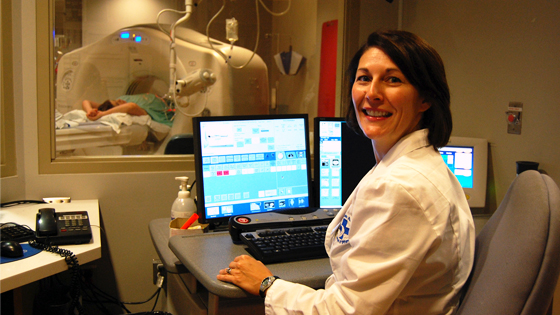
Medical Radiation Technologist Nathalie Gravel and her colleagues are proud of the new high-definition Discovery CT scanner and software that allow lower radiation doses for patients.
Radiation – an invisible property that helps diagnose and treat many diseases – is helpful but must be used responsibly. That’s why Medical Radiation Technologists (MRTs) always try to keep radiation doses for patients and staff as low as possible.
“Every time we take an image or administer a treatment, all aspects of the patient’s safety are carefully considered,” said Brenda Zeran-Joyce, Quality Control Technologist in the Medical Imaging Department. “Advancements have made it possible for MRTs to keep doses to the lowest attainable levels.”
TOH has recently invested in these advances:
- Mobile digital x-ray units. MRTs can use less radiation while still creating high-quality images. The units also allow faster turnaround times so doctors can see the images sooner.
- CT (computed tomography), investment in software and time. Now, most CT exams are done with lower radiation doses.
- Nuclear medicine technique called half-time resolution recovery imaging. This technique allows for lower radioactive doses while maintaining high-quality images.
- Advanced MRI equipment and protocols. Technologists can perform a broad range of procedures using MRIs, such as functional imaging, for conditions previously diagnosed only using CT or nuclear medicine.
- Radiation therapy, on-board cone-beam imaging. This digital x-ray unit produces 3-D images of the patient’s internal anatomy, allowing for smaller areas to be treated with extreme precision.
“This final technology lets us reduce the radiation dose to normal tissues while maintaining the therapeutic dose to cancerous tumours,” said André Patry, Education Coordinator in the Radiation Therapy Department.
MRT Week, Nov. 3 to 9, celebrates the skill and understanding of evolving technology that MRTs contribute to help improve patient care and outcomes. Check out the information kiosks at each campus to learn more about radiation-dose reduction.

Support patient care and research at
The Ottawa Hospital


 To reset, hold the Ctrl key, then press 0.
To reset, hold the Ctrl key, then press 0.